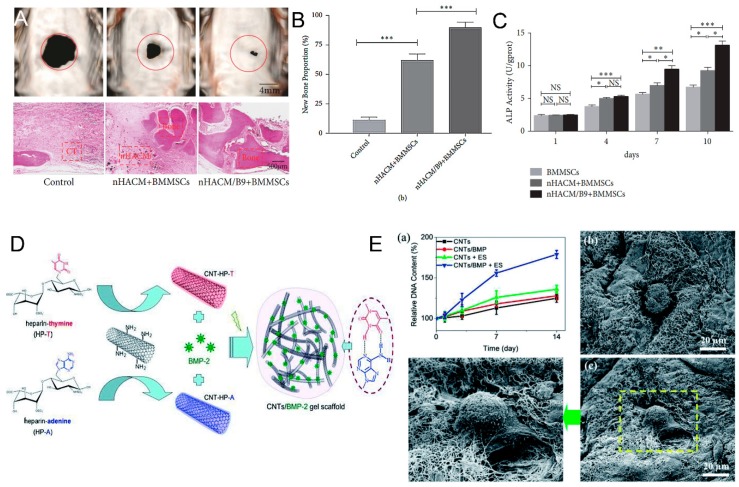Figure 9.
Carbon nanotube (CNT)-based composites as carriers for loading bone morphogenetic proteins (BMPs). (A) In vivo radiographic examinations at 12 weeks postoperatively: analysis of the CT images (top) and hematoxylin and eosin staining on the sectioned slices (bottom) showed a significantly larger area of new bone regeneration on the nHACM/B9+BMMSC (nano-hydroxyapatite–collagen I-MWCNT/human bone morphogenetic protein-9 + bone marrow mesenchymal stem cells) groups. (B) The proportion of new bone formation in vivo and (C) ALP activity in vitro after 4 days of culture in the control, nHACM + BMMSC, and nHACM/B9 + BMMSC groups, indicating that nHACM-B9 scaffolds promoted osteogenic differentiation of BMMSCs. (* p < 0.05, ** p < 0.01, and *** p < 0.001). (D) Schematic assembly diagram of a BMP-2-loaded CNT gelatin (gel)-based scaffold via Watson–Crick base pairing. (E) Proliferation of human adipose-derived stem cells (ASCs) in a BMP-2-loaded CNT gel-based scaffold under electrically stimulus. (a) DNA contents of encapsulated ASCs in CNT gel-based scaffolds as a function of culture time. The DNA content of embedded ASCs in the scaffold changed with culture time. (b,c) SEM images show the CNT matrices contained in the ASCs and BMP-2 after 7 and 14 days of culture. Reproduced with permission from [226,229]. Hindawi and Royal Society of Chemistry: Open Access, 2019.

